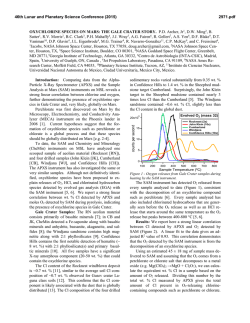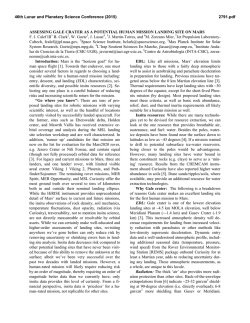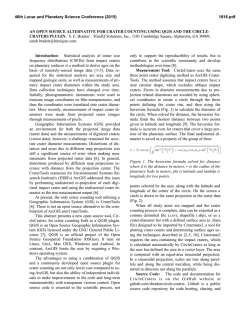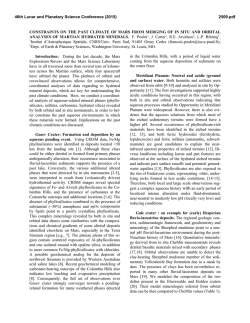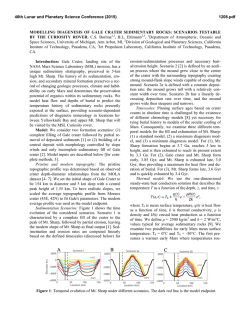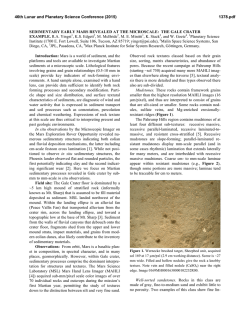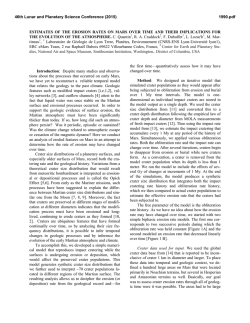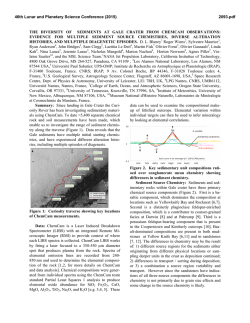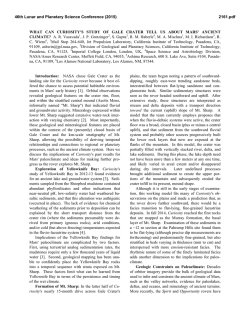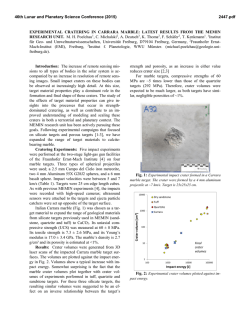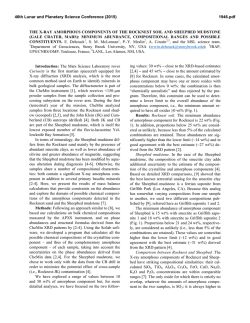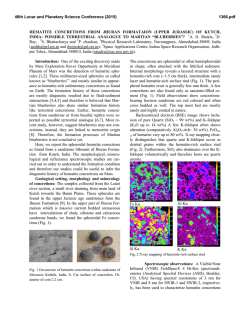
MINERALOGY AND GENESIS OF THE WINDJANA - USRA
46th Lunar and Planetary Science Conference (2015) 2620.pdf MINERALOGY AND GENESIS OF THE WINDJANA SANDSTONE, KIMBERLEY AREA, GALE CRATER, MARS. A.H. Treiman1; Bish D.2, Ming D.W.3, Grotzinger J.4, Vaniman D.T.5, Baker M.B.4, Farmer J.6, Chipera S.7, Downs R.T.6, Morris R.V.3, Rampe E.3, Blake D.F.8, Berger J.9, Cavanagh P.D.2, Gellert R. 9, Glazner A.F.10, Schmidt M.11, Yen A.S.12, Filiberto J.13 and the rest of the APXS and CheMin teams. 1Lunar and Planetary Institute, 3600 Bay Area Blvd., Houston TX 77058. 2Dept. Geol. Sci., Indiana Univ., Bloomington, IN 47405. 3 NASA JSC, Houston, TX 77058. 4Div. Geol. Planet. Sci., Caltech, Pasadena, CA 91125. 5Planet. Sci. Inst., Tucson, AZ 85719. 6Dept. Geology, Univ. Arizona, Tucson, AZ 85721. 7Chesapeake Energy, Oklahoma City, OK 73154. 8 NASA Ames Rsch. Ctr., Moffett Field, CA 94035. 9Physics Dept., Univ. Guelph, Guelph, Ont., N1G 2W1 Canada. 10 Dept. Geol. Sci., Univ. North Carolina, Chapel Hill, NC 27599. 11Dept. Earth Sci., Brock Univ., St. Catherines, Ont. L2S 3A1 Canada. 12Jet Propulsion Lab., Pasadena CA 91109. 13Dept. Geol., Southern Ill. Univ., Carbondale, IL 62901. MSL Curiosity investigated the Windjana sandstone outcrop, in the Kimberley area of Gale Crater, and obtained mineralogical analyses with the CheMin XRD instrument. Windjana is remarkable in containing an abundance of potassium feldspar (and thus K in its bulk chemistry) combined with a low abundance of plagioclase (and low Na/K in its chemistry). The source of this enrichment in K is not clear, but has significant implications for the geology of Gale Crater and of Mars. The high K could be intrinsic to the sediment and imply that the sediment source area (Gale Crater rim) includes K-rich basalts and possibly more evolved rocks derived from alkaline magmas. Alternatively, the high K could be diagenetic and imply that the Gale Crater sediments were altered by K-rich aqueous fluids after deposition. Kimberley and Windjana: The Kimberley area (~4.6°S,137.4°E) was targeted for investigation from orbital (HiRISE) imagery because at least three distinct sedimentary units are exposed in contact there [1]. Uppermost is a massive sandstone, which may include the resistant capping unit encountered frequently on Curiosity’s traverse. Next is a thinly bedded, cross-bedded sandstone – the ‘Dillinger Unit.’ The lowest exposures are of the ‘striated unit’ documented from orbit; it consists of thinly bedded siltstone, sandstone, and minor conglomerate dipping generally to the south. The MSL team selected a target in the Dillinger Unit, named °2θ CoKα Fig. 1. 1-D CheMin XRD pattern for Windjana. Blue line is measured pattern; red line is model (of Table 1). Amorphous material appears as broad hump at mid-range °2θ and strong increase at lowest °2θ (upper gray curve). Gray curve at bottom is difference between measured data and model fit. Windjana, for mineralogical analysis. CheMin X-ray Diffraction: The Windjana rock was drilled on sol 621, following a successful minidrill test of rock properties and stability. The drill sample was sieved to <150 µm, and an aliquot was delivered to CheMin on sol 622 into an unused Mylar cell. It was analyzed [2-4] Table 1. Mineralogy (wt%), Gale for 23 hours total Crater Materials, by CheMin over sols 623–632 Mineral Rocknest‡ Windjana (Fig. 1). A second Olivine 16 5 11 17 aliquot was delivered Augite 10 12 on sol 640 to a Mylar Pigeonite Opx -2* cell that had been Plagioclase 30 2 used previously and K-Feldspar 0.9 16 dumped; it was ana- Pyrrhotite -0.7 lyzed for 22 hours Ilmenite 0.7* 0.9 Magnetite 1.5 13 over sols 640–656. -0.8 2-D diffraction Akaganeite Hematite 0.8 0.6 images were correctAnhydrite 1.1 1.0 ed for geometry and Quartz 1 -hot pixels on the Phyllosilicate 0 8 spacecraft, further Amorphous 27 20 despeckled manually * near detection limit. ‡[20]. on the ground, and converted to 1-D diffraction patterns [5]; results for the pristine cell are discussed here (Fig. 1). Diffraction peaks were identified, and proportions of crystalline phases were determined by Rietveld refinement, using commercial codes Jade® and Topas®; Table 1 is a new refinement. Detection limits for crystalline phases are at best ~0.5% wt. [2], depending on their absolute peak intensities and °2θ positions relative to those of more abundant phases. The proportions of amorphous components were calculated with the program FULLPAT [6]. Both aliquots of the Windjana drill powder contained the same minerals in similar proportions. Mineralogy: The minerals in the Windjana sandstone are typical of basalt, with limited aqueous alteration (Table 1); its mineral proportions are notable for its high abundances of K feldspar and of iron oxides (Table 1). These mineral proportions are reflected in 46th Lunar and Planetary Science Conference (2015) the bulk chemistry by high abundances of K2O and FeO. As in other rock samples analyzed by CheMin, Windjana contains significant proportions of phyllosilicates and amorphous material. The olivine is Fe-forsterite (Fo50-70) and the plagioclase is andesine (~An40). The alkali feldspar is K-rich and partially disordered, based on its b and c unit-cell parameters. A sanidine structurre model gave the best fits; diagenetic K-spar can be similarly ordered. The compositions of augite and pigeonite are not yet constrained. Orthopyroxene (Opx) is present at CheMin’s nominal detection limit, but including it improves the model fit to the diffraction pattern. Many mineral phases suggest low-T alteration or diagenesis. The presence of phyllosilicates is indicated by a sharp diffraction near 1.0 nm (the 001 peak) and a broad shoulder on that peak to lower °2θ (Fig. 1). These diffraction features are consistent with (but not definitive for) ferromagnesian smectites with and without collapsed interlayers (analogous to those in the John_Klein and Cumberland samples); other 2:1 phyllosilicates cannot be excluded. The Windjana sample contains abundant magnetite, and minor hematite, akaganeite [β-Fe3+O(OH,Cl)], and anhydrite. Genesis: The high abundances of K-feldspar and iron oxides in Windjana, also reflected in the APXS chemical analysis as high K and Fe (Table 2) [7], are unusual. The phyllosilicates and iron oxides could represent diagenetic deposits or cements [4,8] as invoked for other rocks in Gale crater. Several rocks analyzed by MSL APXS and ChemCam have high abundances of K2O [9-11], but Windjana is the most extreme. Two explanations of the K abundance have been offered. Potassic Basaltic Source? The high abundances of K-feldspar and K2O in Windjana could represent the primary, detrital comTable 2. Elemental Abundances ponents of the sand(wt%), by APXS. ‡ stone, and thus its Rocknest* Windjana source rocks on the Na2O 2.7 0.4 crater wall and rim. If MgO 8.7 12.8 the Windjana sediment Al2O3 9.4 5.7 SiO2 42.9 39.5 represents a single P2O5 0.94 0.73 source, it would have SO3 5.5 2.6 been ultrabasic (high Cl 0.61 0.79 FeO+MgO), low in Al K2 O 0.49 3.7 & Ca, and ultrapotassic CaO 7.3 4.9 (K2O > 3%, K2O/Na2O TiO2 1.19 1.18 Cr2O3 0.49 0.42 > 2 [12]). Such basaltic MnO 0.41 0.52 rocks, ultrapotassic FeO 19.2 26.3 low-Al komatiites, are Ni ppm 446 380 not known on Earth Zn ppm 337 4300 [13], and would require Br ppm 26 400 *Rocknest = Portage Soil [20] addition of K to the ‡ Average of three analyses. 2620.pdf source region via mantle metasomatism [14]. On Earth, basaltic rocks with abundant K-feldspar rarely contain pigeonite and/or orthopyroxene (but see [15]), which suggests that the Windjana sediments were derived from multiple source lithologies. Potassic Metasomatism/Diagenesis? The high abundances of K-feldspar and K2O in Windjana could have arisen by metasomatism or diagenesis, and so represent aqueous-phase alteration of either the sediment’s protolith or the sediment in place. On Earth, potassic diagenesis is relatively common in clastic and volcanicalastic sediments [16-18], yielding K-feldspar filling voids, and as overgrowths on, or euhedral replacements, of primary detrital plagioclase. On Earth, an authigenic origin is easily demonstrated by microtexural relationships observed in petrographic thin sections — information we presently lack for Mars. Diagenesis like this is consistent with Windjana’s geologic setting in a closed sedimentary basin, its relatively high Zn abundance (Table 2; inferred to reflect mobility via fluids [19]), and the inference that the magnetite could be diagenetic or cement [4]. However, such extensive aqueous alteration seems inconsistent with the persistence of olivine and abundant amorphous material. Conclusions: Several hypotheses could explain the abundance of potassium feldspar observed by CheMin X-ray diffraction of the Windjana drill sample: 1) Detrital K-spar transported from transported from potassium-enriched basaltic source rocks by river systems that fed the crater-fringing alluvial complex; and 2) authigenesis of K-feldspar during the post-burial (diagenetic) alteration of basaltic sandstones, perhaps by the introduction of potassium-rich fluids at elevated burial temperatures. Distinguishing among these ideas will involve coordinated interpretation of data from all of Curiosity’s instruments. We are grateful to all the MSL engineers and scientists. References: [1] Williams R.M.E. et al. (2014) AGU abstr. P42C02. [2] Blake D.F. et al. (2012) Space Sci. Rev. 170, 341. [3] Bish D.L. et al. (2013) Science 341, 1238932. [4] Vaniman D.T. et al. (2014) Science 343, 1243480. [5] Dera P. et al. (2013) High Press. Res. 33, 466. [6] Chipera S.J. & Bish D.L. (2002) J. Appl. Crystallogr. 35, 744. [7] McLennan S.M. et al. (2014) Science 343, 1244734. [8] Blaney D.L. et al. (2014) JGRP 119, 2109. [9] Schmidt M. et al. (2014) JGRP 119, 64. [10] Stolper E.M. et al. (2013) Science 341, 1239463. [11] Sautter V. et al. (2014) JGRP 119, 306. [12] Foley S.F. et al. (1987) Earth Sci. Rev. 24, 81. [13] Earthchem & GEOROC databases: www.earthchem.org/; http://georoc.mpchmainz.gwdg.de/georoc/. [14] Treiman A.H. & Filiberto J. (in press) MaPS, DOI: 10.1111/maps.12363. [15] Goodrich C.A. et al. (2013) MaPS 48, 2371-2405. [16] Kastner M. & Siever R. (1979) Am. Jour. Sci. 279, 435. [17] Fedo C.M. et al. (1995) Geology 23, 921. [18] Glazner A.F. (1988) Bull. GSA 100, 424. [19] Berger J. et al. (2014) AGU abstr. P51E3988. [20] Blake D.F. et al. (2013) Science 341, 1239505.
© Copyright 2025
